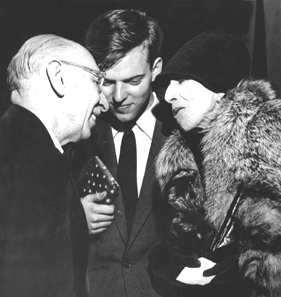Double Canon (Stravinsky) on:
[Wikipedia]
[Google]
[Amazon]
 The Double Canon (Raoul Dufy in Memoriam) is a short composition for string quartet by Igor Stravinsky, composed in 1959. It lasts only about a minute and a quarter in performance.
The Double Canon (Raoul Dufy in Memoriam) is a short composition for string quartet by Igor Stravinsky, composed in 1959. It lasts only about a minute and a quarter in performance.
 The Double Canon (Raoul Dufy in Memoriam) is a short composition for string quartet by Igor Stravinsky, composed in 1959. It lasts only about a minute and a quarter in performance.
The Double Canon (Raoul Dufy in Memoriam) is a short composition for string quartet by Igor Stravinsky, composed in 1959. It lasts only about a minute and a quarter in performance.
History
Although it is a memorial piece for the painterRaoul Dufy
Raoul Dufy (; 3 June 1877 – 23 March 1953) was a French Fauvist painter. He developed a colorful, decorative style that became fashionable for designs of ceramics and textile as well as decorative schemes for public buildings. He is noted ...
, who had died on 23 March 1953, the Double Canon is not a personal tribute, for the two men had never met. The work originated as a duet for flute and clarinet, composed in Venice in September 1959 as a souvenir piece in response to a request for an autograph. Later expanded for string quartet, it had its first performance at a Stravinsky festival in New York, either on 20 December 1959, or else on 10 January 1960 in a concert also featuring the premiere of the ''Movements
Movement may refer to:
Common uses
* Movement (clockwork), the internal mechanism of a timepiece
* Motion, commonly referred to as movement
Arts, entertainment, and media
Literature
* "Movement" (short story), a short story by Nancy Fu ...
'' for piano and orchestra.
Analysis
The Double Canon is exceptional in Stravinsky'stwelve-tone
The twelve-tone technique—also known as dodecaphony, twelve-tone serialism, and (in British usage) twelve-note composition—is a method of musical composition first devised by Austrian composer Josef Matthias Hauer, who published his "law o ...
compositions in that it uses transposed forms of the row
Row or ROW may refer to:
Exercise
*Rowing, or a form of aquatic movement using oars
*Row (weight-lifting), a form of weight-lifting exercise
Math
*Row vector, a 1 × ''n'' matrix in linear algebra.
*Row (database), a single, implicitly structured ...
. Stravinsky's habitual practice was to use only untransposed row forms.
The first five notes of Stravinsky's series for the Double Canon are equivalent to the five-note set of ''In Memoriam Dylan Thomas'', and also are closely related to sets used in '' Agon'', '' Epitaphium'', and '' A Sermon, a Narrative and a Prayer''. It is representative of the earliest phase of Stravinsky's serial practice, when he had not yet developed the technique of hexachordal rotation that characterizes his music written from the ''Movements'' onward.
References
Sources * * * * *Further reading
* Straus, Joseph N. (2004). ''Stravinsky's Late Music''. Cambridge Studies in Music Theory and Analysis 16. Cambridge University Press. pp. 11–18. . * Walsh, Stephen. 1988. ''The Music of Stravinsky''. London and New York: Routledge. See esp. pp. 235–238. {{Authority control Compositions by Igor Stravinsky 1959 compositions Compositions for string quartet Funerary and memorial compositions Twelve-tone compositions